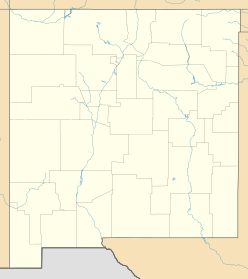Santa Fe impact structure facts for kids

Shatter cones at the side of Highway 475 in the Santa Fe impact structure
|
|
| Impact crater/structure | |
|---|---|
| Confidence | confirmed |
| Diameter | 6 kilometres (3.7 mi)-13 kilometres (8.1 mi) |
| Age | less than 1.2 billion years |
| Exposed | no |
| Drilled | no |
| Location | |
| Location | Sangre de Cristo Mountains |
| Coordinates | 35°43′41″N 105°51′51″W / 35.7281167°N 105.8642106°W |
| Country | United States |
| State | New Mexico |
| District | Santa Fe County |
| Access | SR475 northeast of Santa Fe |
The Santa Fe impact structure is what's left of a giant hole made when a space rock crashed into Earth. This happened a very, very long time ago in the Sangre de Cristo Mountains near Santa Fe, New Mexico. It's called an "impact structure" because it's so old and worn away that it doesn't look like a round crater anymore.
Contents
How Was It Discovered?
The discovery of this ancient crash site happened in 2005. A geologist, who is a scientist who studies rocks and the Earth, was looking at rocks along New Mexico State Road 475. This road goes between Santa Fe and Hyde Memorial State Park. He noticed something special about the rocks: they had strange cone shapes on them.
What Are Shatter Cones?
These special cone shapes are called shatter cones. They are a clear sign that the rocks were hit by an incredibly powerful shock. This kind of shock can only happen in two ways:
- When a huge space rock, like a meteor, crashes into the Earth.
- During a nuclear explosion.
Since there was no nuclear explosion here, the shatter cones proved that a meteor had crashed in this spot.
Why Is It an Impact Structure, Not a Crater?
When a space rock hits Earth, it creates a bowl-shaped hole called an impact crater. Over millions of years, wind, water, and other natural forces wear away the land. This process is called erosion. The Santa Fe impact structure is so old that most of the original crater has been eroded away. What we see today are just the deep rocks that were once at the bottom of the crater. That's why scientists call it an "impact structure" instead of a "crater."
How Old and How Big Is It?
Scientists believe the space rock crashed here between 1.4 and 1.6 billion years ago. That's an incredibly long time! Only the very bottom layers of the original crater are still visible today in the mountains.
The exact size of the original crater is still being studied. However, the shatter cones found along the highway stretch for about 1 mile (1.6 km). This area is thought to be near the center of where the space rock hit. The full crater would have been much wider, possibly between 6 and 13 kilometers (about 4 to 8 miles) across.


